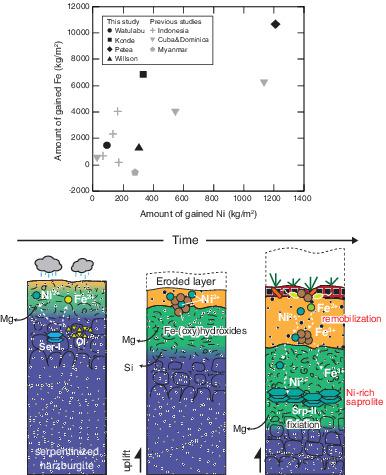Geochemical constraints on the mobilization of Ni and critical metals in laterite deposits, Sulawesi, Indonesia: A mass‐balance approach
IF 0.8
4区 地球科学
Q3 GEOLOGY
引用次数: 8
Abstract
Indonesia is one of the largest Ni ore producers in the world and is also expected to be an important potential source of some critical metals (e.g., Co, Sc, rare‐earth elements, and platinum‐group elements). However, few studies have examined Ni laterite deposits in this country. In this study, we investigate Ni enrichment and the potential accumulation of critical metals in four laterite profiles with varying degrees of serpentinization and weathering intensity in the Soroako and Pomalaa mining areas of Sulawesi, Indonesia. We integrate geochemical evaluation with a mass‐balance approach and mineralogical analysis to better constrain the geochemical factors influencing the mobilization of Ni during lateritization. Nickel contents in the saprolite horizon of the profiles that are strongly weathered and developed over serpentinized peridotite are higher than those that are weakly weathered and developed over unserpentinized harzburgite. The bulk Ni contents of saprolite horizons are related to Ni contents of Ni‐bearing Mg‐phyllosilicates, which suggests that Ni remobilization is the main control on Ni enrichment in the profiles. Mass‐balance calculations reveal that the amounts of gained Fe and Ni in the profiles are positively correlated. This relationship indicates that the redistribution of Ni is likely controlled by the aging of Ni‐bearing goethite (dissolution/recrystallization) involving ligand‐promoted dissolution by organic matter and/or reductive dissolution by microbial activity near the surface. Critical metals show enrichment in specific horizons. Enrichments in Co and rare‐earth elements are strongly influenced by the formation of Mn‐oxyhydroxides in the oxide zone of the profiles. In contrast, Sc, Pt, and Pd show residual enrichment patterns, with grades influenced mainly by their initial contents in bedrock. The profiles show a positive correlation between Sc and Fe, as reported for other Ni laterite deposits. Among the critical metals, Sc, Pt, and Pd contents in the studied profiles are comparable with values reported from other Ni laterite deposits worldwide.

印度尼西亚苏拉威西红土矿床中镍和关键金属的地球化学约束:质量平衡方法
印度尼西亚是世界上最大的镍矿生产国之一,也有望成为一些关键金属(如钴、钪、稀土元素和铂族元素)的重要潜在来源。然而,对我国镍红土矿床的调查研究很少。在这项研究中,我们研究了在印度尼西亚苏拉威西的Soroako和Pomalaa矿区具有不同程度蛇纹石化和风化强度的四个红土剖面中镍的富集和关键金属的潜在富集。我们将地球化学评价与质量平衡方法和矿物学分析相结合,以更好地约束影响镍在红土化过程中动员的地球化学因素。在蛇纹石化橄榄岩上发育的强风化剖面的腐辉岩层中镍含量高于在非蛇纹石化橄榄岩上发育的弱风化剖面。腐岩层体Ni含量与含Ni Mg层状硅酸盐的Ni含量相关,表明Ni再活化是剖面中Ni富集的主要控制因素。质量平衡计算表明,在剖面中获得的铁和镍的数量呈正相关。这一关系表明,镍的再分配可能是由含镍针铁矿的老化(溶解/再结晶)控制的,其中包括配体促进的有机质溶解和/或表面附近微生物活性的还原性溶解。关键金属在特定层位表现出富集。Co和稀土元素的富集受到在剖面的氧化区形成的Mn氢氧化物的强烈影响。Sc、Pt、Pd则表现为残余富集模式,其品位主要受基岩中初始含量的影响。与其他镍红土矿床一样,该剖面显示Sc和Fe呈正相关。在研究剖面中的关键金属中,Sc、Pt和Pd的含量与世界上其他镍红土矿床的报告值相当。
本文章由计算机程序翻译,如有差异,请以英文原文为准。
求助全文
约1分钟内获得全文
求助全文
来源期刊

Resource Geology
地学-地质学
CiteScore
2.30
自引率
14.30%
发文量
18
审稿时长
12 months
期刊介绍:
Resource Geology is an international journal focusing on economic geology, geochemistry and environmental geology. Its purpose is to contribute to the promotion of earth sciences related to metallic and non-metallic mineral deposits mainly in Asia, Oceania and the Circum-Pacific region, although other parts of the world are also considered.
Launched in 1998 by the Society for Resource Geology, the journal is published quarterly in English, making it more accessible to the international geological community. The journal publishes high quality papers of interest to those engaged in research and exploration of mineral deposits.
 求助内容:
求助内容: 应助结果提醒方式:
应助结果提醒方式:


